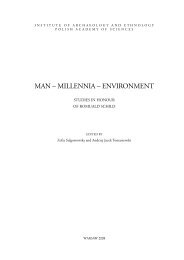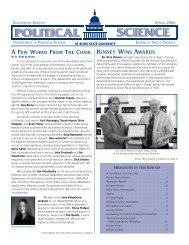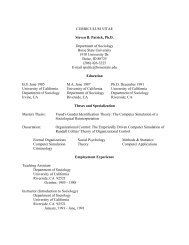From Incivility to Outrage - College of Social Sciences & Public ...
From Incivility to Outrage - College of Social Sciences & Public ...
From Incivility to Outrage - College of Social Sciences & Public ...
Create successful ePaper yourself
Turn your PDF publications into a flip-book with our unique Google optimized e-Paper software.
Downloaded by [Boise State University] at 17:30 21 December 2011<br />
Political Discourse in Blogs, Talk Radio, and Cable News 39<br />
Mayer, W. G. (2004). Why talk radio is conservative. <strong>Public</strong> Interest, 156, 86–103.<br />
Moy, P., & Pfau, M. (2000). With malice <strong>to</strong>ward all. Santa Barbara, CA: Praeger.<br />
Mutz, D. C. (2007). Effects <strong>of</strong> in-your-face television discourse on perceptions <strong>of</strong> a legitimate<br />
opposition. American Political Science Review, 101, 621–635.<br />
Mutz, D. C., & Reeves, B. (2005). The new video malaise: Effects <strong>of</strong> televised incivility on political<br />
trust. American Political Science Review, 99, 1–15.<br />
Nadeau, R., Niemi, R., & Ama<strong>to</strong>, T. (1996). Prospective and comparative or retrospective and individual?<br />
Party leaders and party support in Great Britain. British Journal <strong>of</strong> Political Science, 25,<br />
245–258.<br />
Perrin, A. J. (2005). Political microcultures: Linking civic life and democratic discourse. <strong>Social</strong><br />
Forces, 84, 1049–1082.<br />
Prior, M. (2007). Post-broadcast democracy. New York, NY: Cambridge University Press.<br />
Project for Excellence in Journalism. (2010). State <strong>of</strong> the news media 2010. Retrieved from<br />
http://www.state<strong>of</strong>themedia.org/2010/index.php<br />
Rheingold, H. (1993). The virtual community: Homesteading on the electronic frontier. Cambridge,<br />
MA: MIT Press. Retrieved from http://www.reingold.com/ve/book<br />
Schlozman, K. L., & Tierney, J. (1986). Organized interests and American democracy. NewYork,<br />
NY: Harper & Row.<br />
Sigelman, L., & Park, D. (2007). <strong>Incivility</strong> in presidential campaigns 1952–2000. Unpublished<br />
manuscript.<br />
West, D. M. (2005). Air wars: Television advertising in election campaigns, 1952–2004. Washing<strong>to</strong>n,<br />
DC: CQ Press.<br />
Appendix: Summaries <strong>of</strong> Content Variables<br />
Below are thumbnail descriptions that focus on the underlying concept that we attempted<br />
<strong>to</strong> measure. The codebook has fuller definitions along with a range <strong>of</strong> examples <strong>of</strong> speech<br />
that fall within the boundaries <strong>of</strong> each <strong>of</strong> these.<br />
Insulting Language<br />
This variable is intended <strong>to</strong> measure whether the author or speaker uses insulting language<br />
in reference <strong>to</strong> a person, group <strong>of</strong> people, branch <strong>of</strong> the government, political party, or<br />
other organization, or their behaviors, planned behaviors, policies, or views. For example,<br />
“asinine” in reference <strong>to</strong> a person or group’s behavior is insulting language, but if the<br />
person or group is called “asinine,” this is reserved for the “name-calling” variable.<br />
Name Calling<br />
This is a measurement <strong>of</strong> whether the author or speaker engages in name calling in reference<br />
<strong>to</strong> a person, group <strong>of</strong> people, branch <strong>of</strong> the government, political party, or other<br />
organization. Affectionate, light-hearted teasing is not included. Rather, name-calling language<br />
is characterized by words and contexts that make the subject look foolish, inept,<br />
hypocritical, deceitful, or dangerous.<br />
Emotional Display<br />
This variable captures audio and/or visual emotional displays in reference <strong>to</strong> a person,<br />
group <strong>of</strong> people, branch <strong>of</strong> the government, political party, or other organization (or their<br />
behaviors, planned behaviors, policies, or views). In printed text, such as that in blog posts<br />
or on Web pages, it is unlikely <strong>to</strong> appear <strong>of</strong>ten but would most likely be communicated







